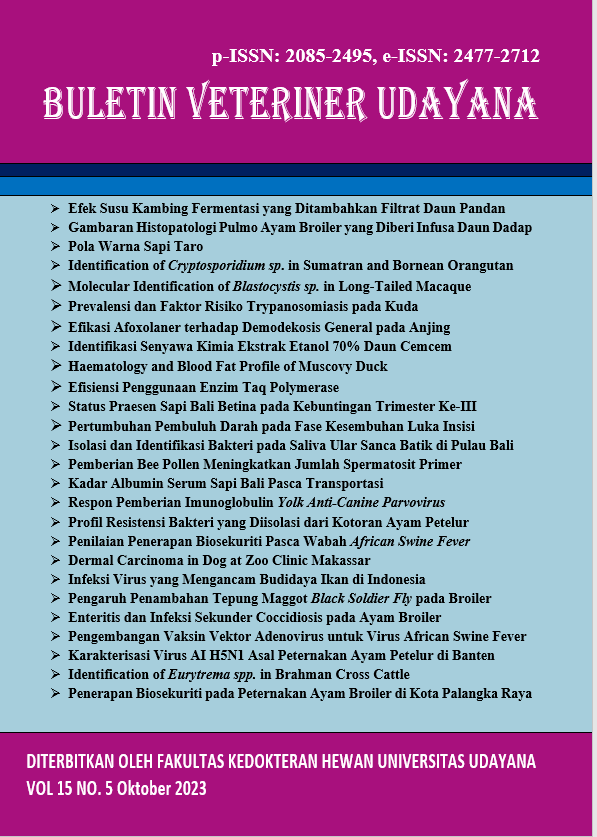COLOR PATTERN OF TARO CATTLE
Abstract
Taro cattle are a group of cattle that are uniquely different from Balinese cattle with a relatively small population and reared in Taro Village, Tegallalang District, Gianyar Regency, Bali and are sanctified and used in religious ceremonies. Taro cattle are characterized by white hair, skin, iris, hooves, and horns. The difference in hair/skin color of taro cattle is due to the influence of melanin pigment. This study is an observational study using purposive sampling technique where 52 male and female taro cattle skin observations were made at Yayasan Lembu Putih with the aim of providing information and scientific evidence as well as guidelines and references for further research. The data obtained were then analyzed using relative frequency (percentage). The results showed that there are other colors found. There are six colors of taro cattle, putih kemerahan color with a total of 40.39%, in females as much as 32.69% and males 7.69%; putih gading color with a total of 38.46%, in females 17.31% and males 21.15%; putih color with a total of 1.92% which is only found in females; sudamala and cemeng colors are only found in the male population 7.69% and 3.85% respectively; and coklat color is only found in the female population as much as 7.69%. Improvements are needed in breeding and mating management, recording systems and checking taro cattle regularly every year.
Downloads
References
Felius M, Koolmees PA, Theunissen B. 2011. On the breeds of cattle historic and current classifications. Diversity. 3: 660-692.
Fontanesi L, Beretti F, Riggio V, Dall'Olio S, Gonzalez EG, Finocchiaro R, Davoli R, Russo V, Portolano B. 2009. Missense and nonsense mutations in melanocortin 1 receptor (MC1R) gene of different goat breeds: association with red and black coat colour phenotypes but with unexpected evidence. BMC Genet. 10: 47.
Gutiérrez-Gil B, Wiener P, Williams JL. 2007. Genetic effects on coat colour in cattle: dilution of eumelanin and phaeomelanin pigments in an F2-Backcross Charolais × Holstein population. BMC Genet. 8: 56.
Gwaza DS, Yahaya M, Ahemen T. 2018. Variation and distribution of qualitative traits of the savannah muturu on free range in the Benue trough of Nigerian. J. Res. Rep. Genet. 2(1): 33-43.
Hardjosubroto W. 1994. Aplikasi pemuliaan ternak di lapangan. Gramedia. Jakarta.
Hardjosubroto W. 2001. Genetika hewan. Fakultas Peternakan Universitas Gadjah Mada, Yogyakarta.
Heryani LGSS, Wandia IN, Suarna IW, Puja IK. 2016. Morphometric characteristics of the taro white cattle in Bali. Glob. Vet. 16(3): 215:218.
Hillis DM. 2004. The genetics of coloration in Texas Longhorns: part 1. Texas Longhorn Trails. 16(3): 40-41.
Klungland H, Olsen HG, Hassanane MS, Mahrous K, Vage DI. 2000. Coat colour genes in diversity studies. J. Anim. Breed. Genet. 117(4): 217-224.
Noor RR, Muladno, Benjamin B, Hedah Z, Herliantin. 2000. Purity test Bali cattle through protein, microsatellite DNA, coat and chromosome structure. Research reports. IPB Faculty of Animal Science and Artificial Insemination Center Singosari. Bogor.
Partama IBG, Putri BRT, Warmadewi DA, Susila TGO, Bidura IGNG, Aryani IGAS, Sumardani LG, Candrawati DPMA, Utami IAP, Wibawa AAPP, Puspani E. 2015. Lembu putih taro maskot Kabupaten Gianyar cetakan pertama. Udayana University Press. Denpasar.
Rees, Jonathan L. 2003. Genetics of haor and skin color. An. Rev. Genet. 37(1): 67-90.
Salako AE. 2013. Genetic and phenotypic profiles of West African dwarf and Yankasa sheep breeds in Nigeria. Int. J. Biodiv. Conserv. 5(2): 47-53.
Sarini NP, Puja IK, Suarna IW, Putra IGAA, Doloksaribu L. 2020. Variations in horn type, horn orientation, and coat color of the Taro white cattle. World J. Engin. Res. Technol. 6(3): 466-478.
Tabun AC, Sumadi, Volkandari DS, Hartatik T. 2013. Identification polymorphism of melanocortin 1 receptor (MC1R) gene in Bali cattle by using PCR-RFLP method. Proc. The 2nd Animal Production International Seminar.





